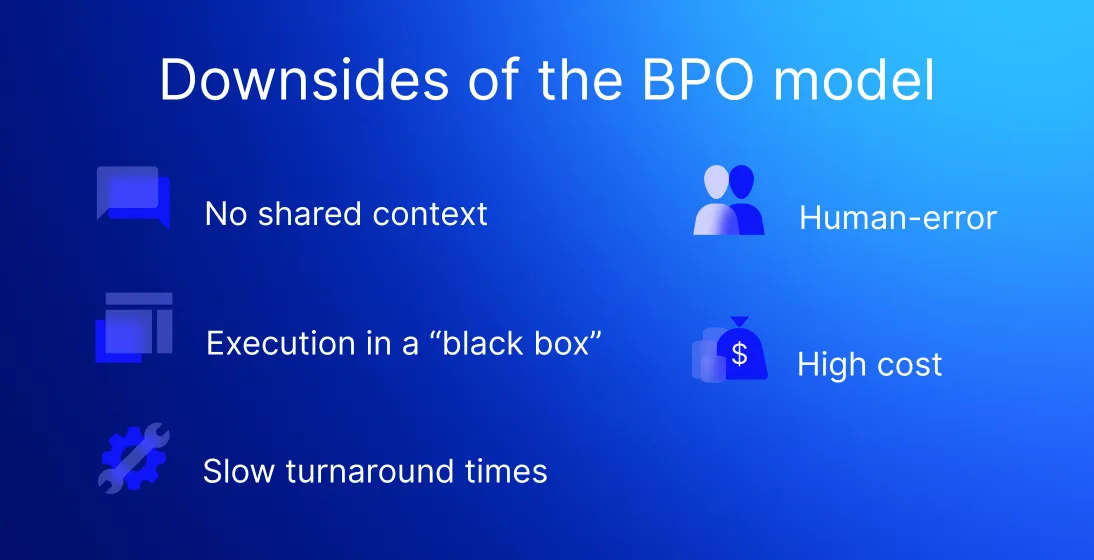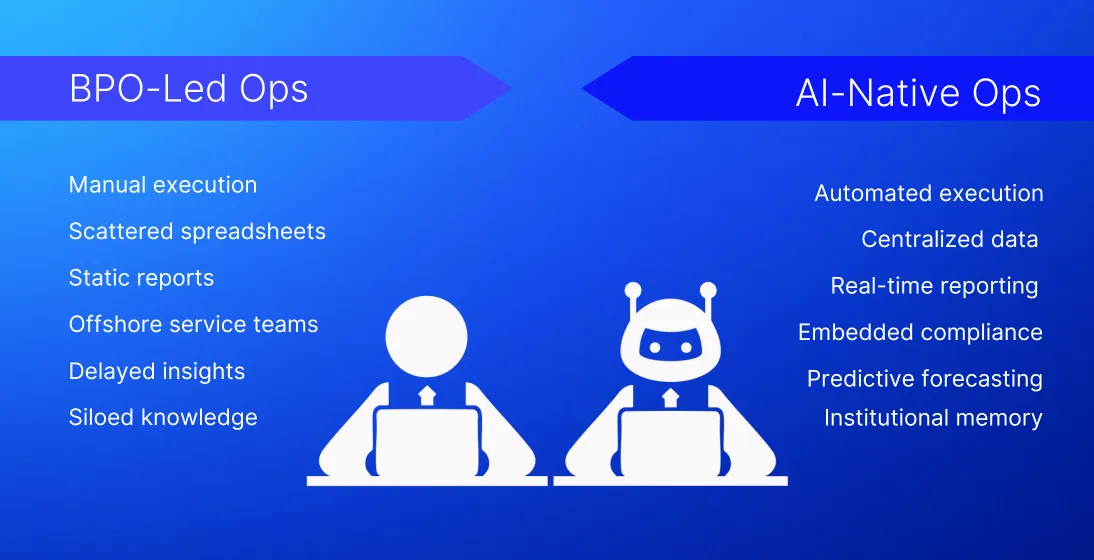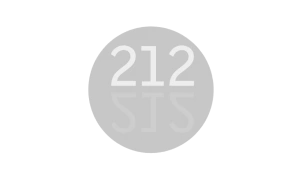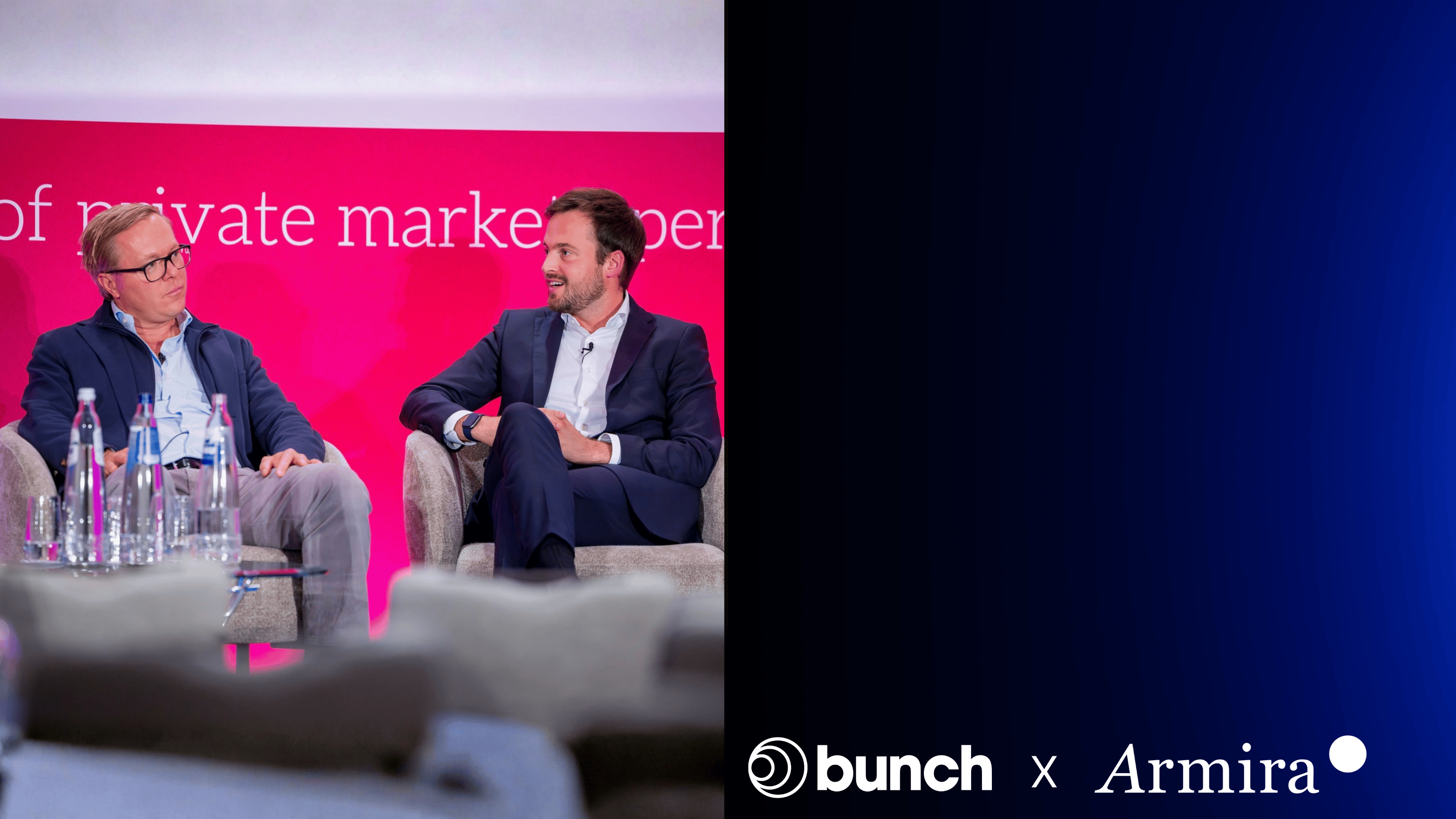Contents
Fund operations weren’t built for the rising AI-driven world fund managers find themselves in today.
Investor expectations around transparency and reporting are intensifying. Beyond that the complexity of due diligence and relative valuations is increasing. Not to mention the boundless access to unstructured data that’s shaping investment narratives faster than traditional workflows can keep up.
There’s a mounting pressure to deliver in an industry that still relies on manual, siloed and unscalable processes. The service-only business process outsourcing (BPO) model no longer fits the needs of modern fund managers. As one CFO of a multi-billion dollar growth-equity platform told us, “My team spends more time explaining what happened last quarter than planning for the next one.”
We are now entering the era of the intelligent execution layer: a software-native approach supported by AI and backed up by experts that preserves fund data within a single system of record, executes workflows autonomously, and drives the structuring of private market data.
And despite only 2% of private equity firms expecting significant AI-driven value this year, 93% anticipate moderate to substantial benefits within the next three to five years. The race is on to turn fund administration from a cost centre into code and fund managers that get there first will compound faster.
.webp)
Fund operations are built on a broken foundation
Modern fund managers are expected to move with speed and precision. But their operations rest on a fragile foundation. And this legacy model has been introducing compounding operational risks.
Scattered spreadsheets, unending email chains, and unrecorded phone calls lead to information siloes and intransparency. Fragmented and static reporting leaves investors with more questions than answers - often even leading to delayed insights due to a lack of real-time updates.
But there’s more. Traditional fund administration has been rooted in manual execution, often outsourced to external providers. This drains valuable time through long review cycles, drives up costs with expensive service fees, and makes cash planning and capital calls reactive - not to mention the compliance risks, audit issues, and errors that come with it.
Slow turnaround times, no shared organizational context, “black box” execution - it’s an error prone model. Sure, BPO used to be the only viable path for lean fund teams. But we’re not living in the 80s anymore, and quite frankly, the model hasn’t evolved much since then. If you’re still relying on offshored labor performing manual tasks through fragmented tools, your fund will soon start falling behind.
Relying on BPO is becoming an operational drag that’s only reducing your fund’s velocity and making scaling harder.

And evolving investor expectations aren’t helping…
Alongside a crumbling BPO model, investor expectations are rising. Transparency and efficiency are now the baseline, and for good reason.
Upcoming changes to ILPA standards are expected to formalize the move toward real-time reporting by 2026. Leading investors already want access to:
- Live fund data, not static PDFs
- Clear audit trails, not fragmented spreadsheets
- Immediate responsiveness, not multi-week back-and-forth
Internally, fund managers are contending with another critical challenge: knowledge loss. Too much operational memory is stuck in someone’s inbox, or disappears when key staff members leave or outsourcing relationships come to an end.
Modern firms need systems that can preserve context and institutional memory across the fund lifecycle without relying on individuals:
- Who said what, to which investor, and why?
- What’s the historical rationale behind a complex waterfall structure?
- What were the edge cases and exceptions in past distributions?
These answers shouldn’t live in someone’s head. They should live in your software infrastructure.
How AI is unbundling BPO
The next wave of fund operations is not just about digitizing paperwork. It’s about replacing execution layers entirely. Already 80% of private equity workflows - like deal sourcing, due diligence, and portfolio management - rely heavily on technologies to be fulfilled.

AI agents can now take this further by performing critical fund workflows faster, more accurately, and with embedded logic. AI can extract, clean, and map transaction data automatically.
The first wave of AI‑native technology companies concentrated on front‑office analytics. Purpose-built machine‑learning models surfaced revenue and earnings patterns, uncovered relationships among comparable companies, and streamlined relative-valuation analysis.
Data-driven forecasting is also evolving. With AI’s support, predictive models can help firms make better risk-return calls by reducing reliance on intuition or bias, improving confidence and speed.
Previously unattainable information is being made accessible with AI, by enabling fund managers to optimize and scale how they extract insights from vast amounts of unstructured, external data - reducing the cost, risk, and time it takes to manually process data. According to the World Economic Forum, AI can evaluate around 195 relevant companies in a fraction of the time it would take a junior analyst to evaluate just one.
These systems also accelerate the time it takes fund managers to conduct due diligence, reducing the usual months and headcount needed to evaluate a potential investment, impacting a fund’s profitability. The use of AI could signify a 25-40% reduction of an average asset manager’s cost base.
And now we enter the next wave targeting tedious back- and middle office workflows, starting with processes like waterfalls, ledgers, audit trails, document analysis, financial modeling, and compliance—they can all be generated in real time and automated with AI, freeing up teams to focus on higher-value work.
Even investor communication and portfolio management can be streamlined with AI. Personalized and real-time reports and updates automate time-consuming communication loops, increase transparency, and improve the timeliness with which VC and PE firms can identify inefficiencies and performance dips in their portfolio companies. This evolution is already underway, as outlined in our recent BCG white paper, which delves deeper in the transformative impact AI is having on the industry.
John Zito, Co-President of Apollo Global Management, summed it up nicely in the “Invest like the best with Patrick O’Shaughnessy” podcast: The shift towards AI is about improving all the operations of financial services companies, and taking large amounts of unstructured data and structuring it into a way that is attractive and potentially even predictive.
The goal of using AI is not to replace human logic and analysis entirely, but to complement fund managers, enhancing their ability to arrive at better investment decisions. As Sid Rajgarhia notes in Forbes, "The traditional VC model leaves enormous amounts of valuable information on the table. By leveraging AI and analytics, we can capture insights from our entire deal flow, not just the small percentage that results in investments."
With all the potential cost and time savings, risk mitigation, and improved strategic depth, it’s only a matter of time before private capital teams become leaner and more software-focused. And when they do, their ROI will thank them for it: According to McKinsey, the effective deployment of tech and AI could 10x institutional investors’ returns across operational efficiency, risk management, and investments.
So what’s holding fund managers back from leaving BPO behind?
Despite the clear limitations of legacy BPO models and the promise of AI-native operations, many fund managers hesitate to make the switch. The road to modern operations comes with its own technical, organizational, and cultural challenges.
- Fear of disruption. Transitioning away from BPO can feel risky, especially during reporting cycles or audits.
- Limited AI fluency. Few teams feel equipped to evaluate, implement, or govern intelligent systems without external support.
- Legacy system inertia. Most fund managers feel at home running a mix of spreadsheets, outdated tools, and vendor-specific workarounds.
- Concerns about control. BPOs often offer perceived peace of mind, while letting software "own" the process feels unfamiliar.
- Data privacy concerns: Strong governance and safeguards are required when working with sensitive financial data to avoid unwanted leaks, and legal or reputational harm.
Still, the cost of staying with BPO is rising. As workflows grow more complex and investor expectations rise, manual execution becomes a liability. And as USPEC puts it, "AI is no longer a luxury that can be bolted on to private equity, it is a necessity if private equity is to continue being successful.”
The bunch approach: Fund operations, reimagined
Fund management software like bunch replaces legacy BPO and static dashboards with a new execution model: an AI-powered system that understands your fund, remembers every nuance, and gets things done for you.
Our platform acts as both your operational copilot and your institutional memory. That means:
- Executing fund operations end to end, from GAAP- and IFRS-compliant accounting to ledgers, carry waterfalls, and reporting.
- Embedding compliance logic directly into workflows.
- Centralizing your data into one AI-native source of truth.
- Automating manual workflows backed by high-touch support where it matters most.
- Surface-level clarity with deep audit trails, real-time updates, and reliable outputs - freeing your team to focus on investor relationships and growth.
Our goal is not to patch up broken workflows with automation, but to rethink how operations should work in the first place: as software-native, AI-powered, service-backed systems. bunch is not another dashboard, it’s your digital fund administrator.
.webp)
The future of fund admin is embedded, intelligent, and instant
With the rise of contextual AI, the traditional BPO model is being challenged - and fund managers are well aware. Private market operations built on spreadsheets, static portals, and outsourced handoffs will no longer compete against the complexity of modern fund management.
Intelligence must be embedded at the core. Software must own the result, not just the process. And fund managers must be able to scale without sacrificing visibility or control.
The use of AI is slowly becoming a necessity, not an option for private markets. Will you stay ahead of the curve? Or will you still rely on old-school BPO?
The best already build on bunch




.webp)
























.webp)

